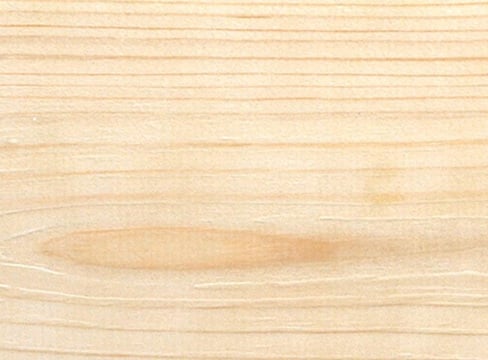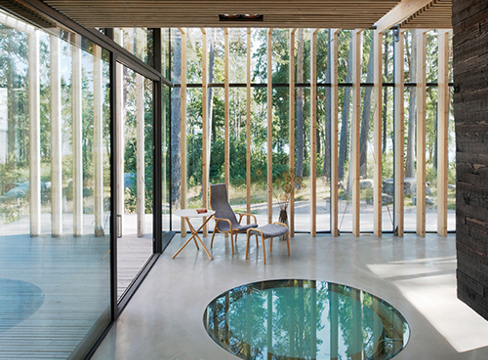Handling and storage
Wood offers good durability as long as it is handled correctly. To preserve the high quality of the wood until it is built into the structure, it should be protected from precipitation, sun, dirt and ground moisture.
Plan and prepare
Plan deliveries to match the pace of production; order materials in batches and prepare for their delivery and storage. Always ensure that the wood is delivered in packaging which is not transparent.
Wood to be used in interior applications where it will be seen, such as mouldings, cladding and floorboards, must be stored in a well-ventilated space with a typical indoor climate.
Wood for outdoor use and encasing should be stored in an outdoor climate, protected from precipitation. Lay the wood flat in a well-drained location. Always use enough supports to avoid the pack of wood bending. Use clean supports. Make sure air can circulate around the pack of wood. Keep wood-based materials at least 300 mm above the ground or floor.
Choose a storage place where water will not pool under the wood. Asphalt or coarse macadam is a good underlay, as there is minimal risk of soil and dirt splashing up.
The ground should be cleared of snow. Do not place the wood where there is a risk of soiling and splashing from guttering or traffic, for example. Make sure the storage location is in the shade in spring, summer and autumn. Packs of wood in sunlight will become warmer than the ambient temperature, which can lead to condensation. This then increases the risk of microbial growth (particularly on the outer layer).

Reception and inspection
Inspect the wood when taking receipt of the delivery.
- Packaging: check that it is intact
- Quantity: make a rough estimate of the quantity
- Dimensions: check that they match the order and the delivery note
- Grades: check the delivery, noting any visible damage. Check the type and labelling against the order and delivery note
- Check that the wood is clear of soil and dirt
- Moisture content: check a number of pieces with a moisture meter to get an indication that the moisture content matches the order. See also the section Measuring average moisture content and surface moisture content.
If, on delivery, the moisture content or grade does not match the order, put in a complaint about the wood immediately.
If a complaint is not registered on receipt of the goods, it can be difficult to resolve a dispute at a later date. In the event of a dispute, sampling is to be performed in line with the prevailing SIS-CEN/TS 12169, with the moisture content requirements set out in SS-EN 14298.
Note
The whole content of the wood package must be available for inspection in the event of a complaint.

Protect the wood
Check that the tarpaulin is intact before covering the pack of wood.
Cover the wood so that the air can circulate and so as to avoid too high a temperature or condensation arising. Leave straps and packaging on the wood for as long as possible.
Ventilate between the wood and the tarpaulin and make sure that the tarpaulin ends are a good way above the ground. Place spacers or similar around the pack of wood so that the tarpaulin does not touch the wood at any point
Direct sunlight will quickly dry out the surface. Cracks will form, the wood might become deformed and it could become moister on the side in shade.
Note
The wood should therefore also remain covered during daylight/working hours. Do not use a transparent cover.
If water has made its way into the pack of wood, the wood must be dried before use. Break open and remove the packaging. Sticker the wood. Cover and leave to dry. Place it in an open location if during the summer. Wood that has warped should be discarded.
Place it indoors with a construction fan if it is a cold time of year. Check the moisture content and the surface moisture content before the wood is used.

Safeguard the moisture content
Structural timber
A batch of construction timber or external cladding normally has a target moisture content of 16% on delivery from the sawmill. The wood can be stored in the packaging outdoors for a short time, as long as it is fully protected against precipitation and moisture absorption. To cover the wood, use fully waterproof tarpaulins. Make sure that moisture does not rise from the ground under the tarpaulin and that air can circulate around and over the pack of wood. Place the pack of wood in the shade.
Glulam
The moisture content of a batch of glulam is usually no more than the target moisture content of 16% on delivery from the glulam manufacturer. Glulam is covered to protect it in transit. If the packaging is fully sealed, glulam can be stored outside under a roof for a short time. If the packaging is broken, mend it (even minor tears) or remove it entirely and then store the glulam in a dry and warm place if being used indoors. Glulam that is to be used in unheated buildings or in an outdoor climate, protected under a roof, can be stored in a cold place, well protected from precipitation.
Mouldings, interior cladding and floorboards
A batch of mouldings, interior cladding and floorboards will usually have a target moisture content of 8% on delivery from the manufacturer. They should be wrapped in six-sided plastic packaging and have a moisture content that is tailored to the application in the finished building. Do not, therefore, store these materials on the construction site. Make sure they are not delivered or fixed until drying of the initial moisture in the building has been completed. If they do have to be stored on the construction site, it should be in a location with an indoor climate.

Table 33 Weight figures for handling
Use the following weight figures when handling solid wood and glulam:
| Wood type | Weight (kg/m3) |
| Spruce | approx. 470 kg/m3 |
| Pine | approx. 500 kg/m3 |
| Glulam | approx. 500 kg/m3 |
| Treated glulam | approx. 600 kg/m3* |
| Treated wood | approx. 830 kg/m3** |
* dried laminates after treatment
** not dried
Waste
Sort wood waste as a separate category that can then be chipped and burned for energy recovery. Waste from treated wood should be handled in line with instructions from the municipal environmental office.
Order the right wood and the right moisture content
Be clear about the requirements for the wood. Order structural timber that complies with SSEN 1611-1 and SSEN 1611-1/A1 or with the requirements for construction timber in SSEN 14081-1 and 14081-3 and graded according to SS-EN 338.
Construction timber, exterior cladding and interior cladding are ordered in dimensions as set out in SS 232712, SS 232813 or the VilmaBas online resource. Exterior or interior cladding should have properties and be labelled in line with SS-EN 14915.
Order glulam that is produced using adhesive that meets the requirements for Type I in SS-EN 301 and is classified in accordance with SS-EN 14080.
Mouldings should be graded in line with SS 232811 and have dimensions as set out in SS 232812. The Swedish VilmaBas project provides an industry-wide list of available products with dimensions, grades and designations, see www.vilmabas.se.
See also the regulations and advice in Boverket’s Building Regulations (BBR), the regulations in AMA Hus and the advice and instructions in RA Hus.
Table 34 Examples of target moisture content on delivery from manufacturer for different applications
| Target moisture content (%) | Use |
| 8 | Floorboards indoors in heated rooms |
| 12 | Floorboards indoors in heated rooms. |
| 16 | Solid wood and glulam for encasing and exterior cladding. |



 Torsbybadet, Torsby.
Torsbybadet, Torsby.

